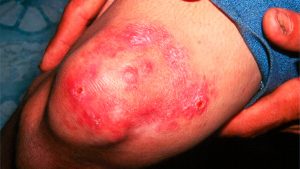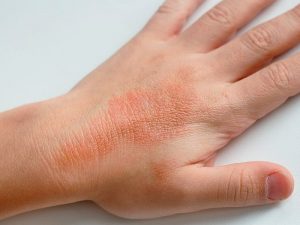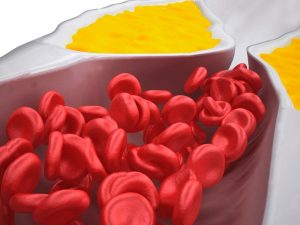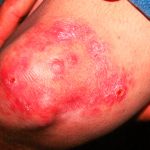What is Scabies?
Scabies is the reaction to the parasitic infestation of Sarcoptes scabiei var hominis. The hardly visible mites burrow into the skin and lay eggs, causing an immune response of vigorous itching. It takes four to six weeks for a reaction to occur in people who have never been infected with scabies and one to four days in those with previous exposure. Common sites for mites to burrow are in the folds and cracks of the skin, ‒ for example, the fingers and toes, bends of the knees, under the thighs, genital folds, around the nipples (in women), under fingernails, under jewelry and around the belt area. It takes only a few mites to illicit a reaction, which can then lead to a bacterial infection. The most visible sign of scabies is skin sores (impetigo) brought on by the infection. Impetigo reactions are more likely to develop in tropical conditions. Scabies sores can lead to more serious conditions such as septicemia, heart disease and chronic kidney disease. Mites, creamy white in colour, are extremely small. If you were to look at a scabies mite under a microscope you would see a round body and eight legs.
Norwegian Scabies
Norwegian or crusted scabies is another form of scabies that occurs in people with weak immune systems (immunocompromised), the elderly, disabled or debilitated. A thick crust of skin is formed that holds a large number of mites and eggs. Crusted scabies is far more serious than regular scabies, so prompt and aggressive medical care is necessary.
How do you get Scabies?
Scabies is contagious. Prolonged skin-to-skin contact with someone who has been infected puts you at extreme risk of acquiring scabies, according to the Centers for Disease Control and Prevention (CDC), scabies is most frequently spread among adults through sexual contact. Living in the same house as someone infected with scabies is another common way to become infected this can happen by sharing sheets, towels or clothes. Those with Norwegian scabies are extremely contagious, and can spread their infestation through direct skin-to-skin contact as well as indirect contact. Animals cannot spread human scabies, and suffer from their own class of mite. Animal mites can spread to humans, but they are unable to reproduce on human skin and cause only mild itching, then die. If you suspect your animal has been infected by mites, get it treated.
Who’s at Risk?
Everyone carries the risk of getting scabies, even those with good hygiene. Those at a higher risk of infection include:
- People living in crowded, close communities.
- Infants and children.
- Elderly people.
- Healthcare professionals treating those with undiagnosed scabies.
- People in tropical climates.
Fast Facts
According to the World Health Organization (WHO), scabies affects more than 130 million people worldwide at any one time.
- WHO estimates the direct effects of scabies led to more than 1.5 million YLDS (years lived with disability) in 2010.
- Ten per cent of children with scabies in underserved communities are found with evidence of renal damage.
- Rates of reported scabies globally varied between 0.3 per cent and 46 per cent.
Scabies Symptoms
Symptoms that could indicate scabies, according to the Cleveland Clinic, include:
- Intense itching.
- Skin rash (can appear similar to pimples).
- Loss of sleep due to itching.
- Infected sores.
Talk to your healthcare professional immediately if you suspect you have been infected with scabies to avoid spreading the infection.
How to Get Rid of Scabies
Removed from human skin, scabies can last two to three days, but the CDC recommends the following measures to remove scabies from your home:
- Wash in hot water, or dry-clean bedding, towels, and clothing. If infected items cannot be washed or dry-cleaned, keep them away from skin contact for at least 72 hours, (try sealing in plastic). Dry with dry heat.
- Vacuum furniture and carpets.
- Fumigate living areas.
- Scabies die when exposed to temperatures of 122F for 10 minutes.
- Get other family members in the house checked for possible spread of infection.
Treatment
Treatment works quickly. The Cleveland Clinic states that infected people can return to school or work the day after treatment. Scabies treatment requires a trip to the doctor. According to the CDC, no over-the counter treatments have been tested and approved to treat scabies. The treatments used for scabies are called scabicides ‒ they kill both the mites and eggs. Scabicides come in a lotion or cream and applied to the entire body, starting at the neck and going to the toes. In the case of young children, the CDC recommends that cream be applied to the head and neck as well. There are specific scabicide ointments for children that your healthcare professional will instruct you on how to use. The treatment is always applied to a clean, followed by a change of clean clothes. Follow medication instructions exactly ask your doctor if you have questions about treatment. Doctors will often prescribe an antihistamine to relieve the itching, which can last four to six weeks after treatment.
Scabies Testing
If you or a sexual partner has been infected with scabies, both people should be tested for infection. Often the test is simple and the doctor can tell there is an infection by closely examining the skin for a rash or mite burrows. Burrows appear as grayish-white raised lines on the skin. In some cases, the doctor will take a skin scraping for microscope examination. Mites, eggs and mite fecal matter can be found in skin samples. Healthy people with fewer than 10 to 15 mites can be infected.











